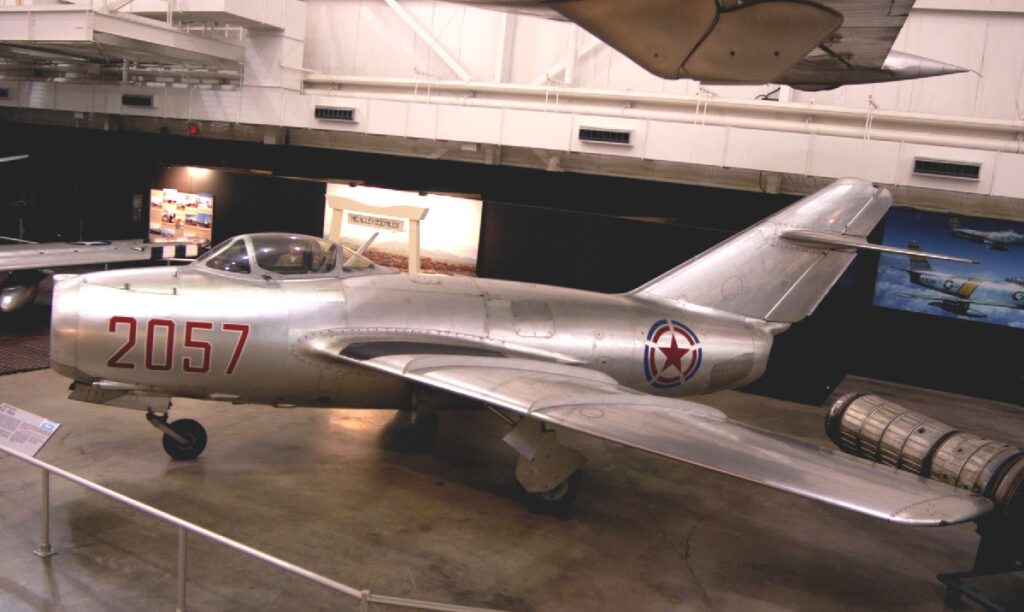‘We were both at idle with our speed brakes out, just coasting. He looked over at me, raised his hand, and shook his fist. I thought, “This is like a movie. This can’t be happening!”,’ Captain Robinson “Robbie” Risner.
The first conflict in which planes engaged in aerial combat for control of the skies was the Korean War. The greatest fighters in the conflict, the USAF’s F-86 Sabre and the Soviet-designed MiG-15, engaged in aerial combat over the Yalu River from late 1950 until the ceasefire in July 1953. Only 140 Sabres from the 51st and 4th Wings stood in their way when the communists rushed more than 500 MiG-15s into bases in Manchuria in an effort to seize aerial superiority over North Korea from the USAF-dominated United Nations Forces.
According to the written guidelines, US pilots were not allowed to fly north of the Yalu River, and many squadron commanders had zero tolerance for infractions. More MiGs perished in their “safe zone” than will ever be known, though. The F-86 pilots abandoned the pursuit at the river and were never able to return, leaving dozens of communist aircraft limp back to base with significant damage.
The eight-victory ace Captain Robinson “Robbie” Risner, who would later go on to become a well-known POW at the Hanoi Hilton during the Vietnam War, is said to have committed the most flagrant border breach, according to Thomas McKelvey Cleaver in his book MiG Alley. Risner, regarded as one of the Air Force’s most aggressive pilots, had initially arrived in Korea as a recon pilot and had convinced the assignment officer in Seoul to send him to the 51st Wing, where he was initially not welcomed as a “real” fighter pilot. On October 22, 1952, he proved his skill as a fighter pilot by winning a fierce battle and turning into an ace.
Risner chased four MiGs across the Yalu that day while assigned to escort fighter bombers on a mission near the Yalu. He eventually found the fourth MiG deep in Manchuria and fired a burst that destroyed the enemy’s canopy. Attempting to escape, the MiG pilot entered a split-S and managed to pull out 10 feet above a dry riverbed, so low that Risner saw the exhaust kick up dust.

Afterward, Risner spoke of the conflict. “He was not in very good shape, but he was a great pilot, and he was fighting like a cornered rat!” To cause Risner to overshoot, the MiG pilot extended his air brakes and pulled the throttle to idle, but Risner rolled over the opposing fighter and touched down on the opposite side just next to its wingtip.
‘We were both at idle with our speed brakes out, just coasting. He looked over at me, raised his hand, and shook his fist. I thought, “This is like a movie. This can’t be happening!” He had on a leather helmet, and I could see the stitching in it.’
All the way back to Tatung-kou airfield, 35 miles inside Manchuria, the enemy pilot bravely avoided Risner as the hunt continued. Once above the field, 1st Lt Joe Logan, Risner and his wingman pursued the MiG tenaciously as it flew between two hangars. When Risner finally managed to fire, a portion of the enemy’s wing was destroyed and crashed next to the runway.
Chinese antiaircraft fire damaged Logan’s fuel tank during the swift pass between the hangars. Risner instructed him to turn off his engine as jet fuel began to stream out of his Sabre and attempted to push the aircraft to safety by inserting the F-86’s snout into Logan’s jet pipe. After two attempts, Risner was forced to retreat when hydraulic fluid and fuel that had been venting covered his canopy. Logan ejected near Cho-do Island, but the wind caught him in his parachute, and he drowned.
Risner was returning to Kimpo when he ran out of gas, but he was still able to glide and land safely making a successful dead-stick landing.
MiG Alley is published by Osprey Publishing and is available to order here.
Top image from ‘F-86 Sabre vs MiG-15’ by Doug Dildy and Warren Thompson © Osprey Publishing

Photo by U.S. Air Force

